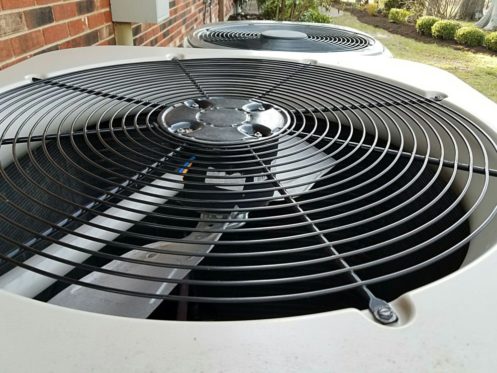You’ve been counting on your air conditioner day in and day out during the summer months. One day you look and see a scary sight: flecks of mold gathering on your AC vents. Has your trusty cooling system become a health hazard? It is possible. By learning more about AC mold, you can take steps to protect your family.
Dangers of AC Mold
The first thing to know about AC mold is that it can be a serious problem. Like mold elsewhere in your home, mold in the air conditioner can cause a variety of respiratory issues and other symptoms. They include:
- Headaches
- Itchy eyes
- Runny nose
- Skin irritation
- Sore throat
People with compromised immune systems, including the young and the elderly, may be particularly affected.
When mold is located in your AC system, it can quickly end up all throughout your house. As the air conditioner runs, it may spread mold spores to each room. That can compound your mold issue.
To avoid that trouble, be on the lookout for signs of AC mold. A musty smell is one indicator. The presence of dark dust near the unit or visible mold growth can also tip you off to the problem. Mold on the air conditioner may be green, white, gray, black or another color. If you suspect that there’s a mold issue, turn the unit off until the problem has been addressed.
Mold in Window AC Units
Now that we have impressed upon you the importance of dealing with air conditioner mold, it’s time to discuss why it might happen. The more you know about causes, the more equipped you’ll be to prevent the problem from occurring in the first place or to avoid a recurrence.
Your window air conditioner probably sits unused all winter long. That’s a perfect time for mold to flourish. Mold likes damp places. It also requires a food source. Unfortunately, it doesn’t take much to feed mold. All it needs is some organic material, which can be found in regular household dust.
If you put away your AC unit for the winter with moisture and dust on it, there’s a chance that you’ll start the next cooling season with a flourishing mold colony on your hands. If there is a water reservoir, be sure to empty and dry it before storage. Also, vacuum the interior of your window unit every few weeks throughout the summer and again before storing it for the winter.
A mold problem could develop mid-summer too, especially if the unit gets wet inside. Make sure that there is a good seal between the AC and the window frame to avoid rainwater leaks.
Also, make sure that your system is draining properly. If moisture builds up in the unit instead of draining, you could be looking at a mold issue. On a portable unit, remove the reservoir and dump out the contents regularly. For window units, angle the back of the unit toward the ground to make sure it drains properly. If your air conditioner still doesn’t drain, it may need to be repaired or replaced.
Finally, keep an eye on the humidity level in your home. A humid house can lead to condensation on your AC components. Even when you’re away from home for a few days, keep the air running in order to maintain a healthy temperature and humidity level. Plus, with air moving through the system, mold spores will be less likely to settle in for the long haul.
Mold in Central Air Systems
Some of the same problems that cause mold in window units can also be an issue for central air systems. For example, mold could develop over the winter if the air conditioner sits unused for several months. Humidity and moisture issues could help fuel that growth. With central air, though, there are some additional protections that can help safeguard your home against mold.
It’s smart to have an air conditioner tune-up at the beginning of the cooling season. During an inspection, our technicians can look for any signs of mold and address them before you start running the AC for the year. Plus, they will also ensure that all drainage systems are working properly. For instance, the condensate drain could have a clog that needs to be cleared.
If you ever spot evidence of moisture around your unit, call for a repair right away. Puddles are a sure sign that something is not right. The sooner you take care of the problem, the lower the chances of developing mold are.
As long as your system stays dry, there’s a good chance it will stay mold-free. The air that moves through your ducts and vents makes it hard for mold to take up residence. But if you introduce water into the system, all bets are off. Always clean ducts, vents and other components with a vacuum or a dry rag.
Take a rag or a vacuum to the grates often. Dust buildup could block the vents and prevent proper airflow. Don’t allow furniture or other household items to block the vents either.
Pay attention to your filters, too. Change them regularly to avoid blockages that could reduce airflow. Invest in high-quality filters that are able to trap mold and other fine particles. For additional protection, you may want to talk to us about adding a UV purifier or a whole-home humidifier to your system.
Solutions for Air Conditioner Mold
Mold in your air conditioner can be a serious problem. How you address it will depend on what type of AC system you have and how extensive the problem is.
For a window air conditioner, it may be easiest to just replace the unit. Often, the mold you see on the outside is only a fraction of the real problem. The mold may be laced throughout the unit.
If the mold is limited to just a small area, such as the housing, the front grille, or the coils, you may be able to clean it with a bleach solution. Be sure to wear protective gear, such as goggles and a face mask while cleaning.
For more complicated cleaning jobs, you will probably need to call in the help of a professional. It’s typically more cost-effective to simply buy a new unit. This might also be a good time to consider installing a central air system instead.
For whole-home AC units, professional help is a must when it comes to mold eradication. By the time you notice the mold, it may have spread throughout the ducts or other parts of the system. We can assess the situation and use the appropriate cleaning methods. Our technicians can also remedy the situation that led to mold growth in the first place.
When you need air conditioner care in the Carrollton area, turn to the experienced team at Dring Air Conditioning & Heating. We do AC installations, repairs and more. We’re your reliable source for heating care, ductwork installation and indoor air quality services, too. Call Dring Air Conditioning & Heating to schedule your appointment today!







